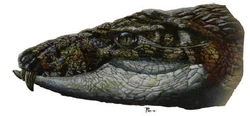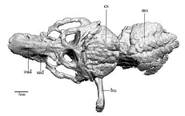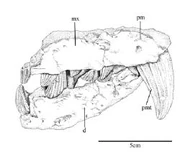| Armadillosuchus Fossil range: Late Cretaceous | |
|---|---|
 Life restoration of the head of Armadillosuchus. | |
| Scientific classification
| |
|
Class |
|
|
Superorder |
|
|
Suborder |
|
|
Family |
Sphagesauridae |
|
Genus |
Armadillosuchus |
|
| |
Armadillosuchus is an extinct genus of sphagesaurid crocodylomorph that was described in February of 2009. It lived during the Late Cretaceous, and the holotype was uncovered from the Bauru Basin of Brazil.[1] Sphagesaurids share a number of mammal-like features in their teeth and jaws, although they are unrelated to mammals.
Description[]
Armadillosuchus is especially mammal-like in that it had heavy body armor characterized by flexible bands and rigid shields that covered its back, less like the traditional osteoderms that line the backs of most crurotarsans and more like that of a modern armadillo (hence the genus name meaning "armadillo crocodile"). Because of its unique morphology, it is believed to have had a terrestrial and quite possibly fossorial lifestyle.
Right behind its head was an armored dome of hexagonal plates. This bony buckler was rigid, but could be moved independently of the head so that the neck was not always locked in one position. Behind this "cervical shield" was a series of seven mobile armored bands. This armor is very similar to what is seen in living armadillos, and the authors of the paper hence chose the name Armadillosuchus. In addition to the armor bands, Armadillosuchus had large hand claws, a shortened snout, and teeth that differed throughout its mouth.
Armadillosuchus had large, curved "canine" teeth and shorter teeth that stuck out straight forward at the front of the lower jaw, as well as stubby conical teeth with shearing ridges. The paleontologists who described it were not sure what it ate, but based upon its dentition, Armadillosuchus may very well have been an omnivore. The large hand claws also suggest that it was a digger, possibly rooting about in the ground after food, similar to the habits of modern armadillos.
The Bauru Basin, where the holotype was found, has a well-preserved fossil record of crocodilians from the Late Cretaceous, including the terrestrial species Montealtosuchus arrudacamposi.
References[]
- ^ Marinho, Thiago S.; and Carvalho, Ismar S. (2009). "An armadillo-like sphagesaurid crocodyliform from the Late Cretaceous of Brazil". Journal of South American Earth Sciences 27 (1): 36–41. doi:.

